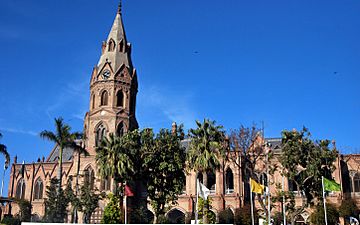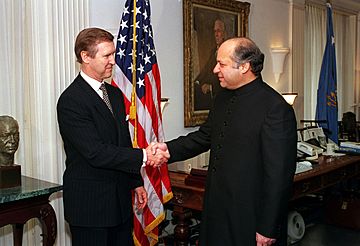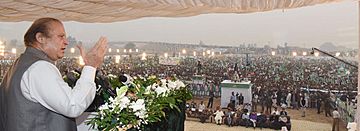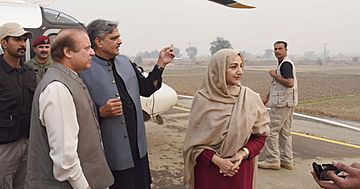Nawaz Sharif facts for kids
Quick facts for kids
Nawaz Sharif
|
|
|---|---|
|
نواز شریف
|
|
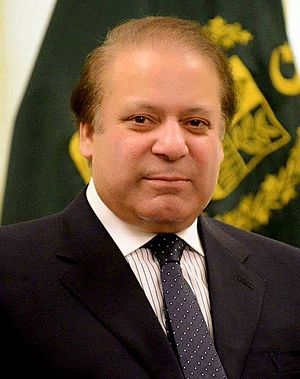
Official portrait, c. 2013
|
|
| 12th Prime Minister of Pakistan | |
| In office 5 June 2013 – 28 July 2017 |
|
| President | Asif Ali Zardari Mamnoon Hussain |
| Preceded by | Mir Hazar Khan Khoso (caretaker) |
| Succeeded by | Shahid Khaqan Abbasi |
| In office 17 February 1997 – 12 October 1999 |
|
| President | Farooq Leghari Wasim Sajjad (acting) Rafiq Tarar |
| Preceded by | Malik Meraj Khalid (caretaker) |
| Succeeded by | Pervez Musharraf (chief executive) |
| In office 6 November 1990 – 18 July 1993 |
|
| President | Ghulam Ishaq Khan |
| Preceded by | Ghulam Mustafa Jatoi (Caretaker) |
| Succeeded by | Moeenuddin Ahmad Qureshi (caretaker) |
| Leader of the Opposition | |
| In office 19 October 1993 – 5 November 1996 |
|
| Preceded by | Benazir Bhutto |
| Succeeded by | Benazir Bhutto |
| President of Pakistan Muslim League (N) | |
| In office 2017–2018 – 28 May 2024–present |
|
| Preceded by | Shehbaz Sharif |
| In office 27 July 2011 – 16 August 2017 |
|
| Preceded by | Javed Hashmi |
| Succeeded by | Sardar Yaqoob (interim) |
| In office 6 October 1993 – 12 October 1999 |
|
| Preceded by | Post created |
| Succeeded by | Kulsoom Nawaz Sharif |
| 9th Chief Minister of Punjab | |
| In office 9 April 1985 – 13 August 1990 |
|
| Governor | Ghulam Jilani Khan Sajjad Hussain Qureshi Tikka Khan |
| Preceded by | Sadiq Hussain Qureshi |
| Succeeded by | Ghulam Haider Wyne |
| Member of the National Assembly of Pakistan | |
| Assumed office 29 February 2024 |
|
| Preceded by | Waheed Alam Khan |
| Constituency | NA-130 Lahore-XIV |
| In office 1 June 2013 – 28 July 2017 |
|
| Preceded by | Bilal Yasin |
| Succeeded by | Kalsoom Nawaz |
| Constituency | NA-120 Lahore-III |
| In office 3 November 1990 – 12 October 1999 |
|
| Preceded by | Mian Muhammad Azhar |
| Succeeded by | Muhammad Pervaiz Malik |
| Constituency | NA-95 Lahore-IV |
| Provincial Minister for Finance of Punjab | |
| In office 1981–1985 |
|
| Member of the Provincial Assembly of Punjab | |
| In office 1980–1990 |
|
| Constituency | PP-105 Lahore-XII |
| Personal details | |
| Born |
Mian Muhammad Nawaz Sharif
25 December 1949 Lahore, West Punjab, Pakistan |
| Political party | |
| Other political affiliations |
|
| Spouse | |
| Children | 4 (including Maryam Nawaz) |
| Relatives | See Sharif family |
| Alma mater | Govt. College University University of the Punjab |
| Signature |  |
Mian Muhammad Nawaz Sharif (born December 25, 1949) is a Pakistani politician and businessman. He served as the 12th prime minister of Pakistan three times. His terms were from 1990 to 1993, 1997 to 1999, and 2013 to 2017. He is the longest-serving prime minister in Pakistan's history, holding the position for over nine years in total. Each of his terms ended with him leaving office.
Nawaz Sharif was born into the well-known Sharif family in Lahore, Punjab. His father, Muhammad Sharif, founded the Ittefaq and Sharif business groups. Nawaz studied business at Government College and law at the University of Punjab. He began his political career in 1981 when he became the finance minister for the province of Punjab.
In 1985, Nawaz was elected as the chief minister of Punjab. He was re-elected in 1988. In 1990, he became the leader of the conservative Islami Jamhuri Ittihad and then the 12th prime minister of Pakistan. After leaving office in 1993, he served as the leader of the opposition until 1996.
Nawaz Sharif became prime minister again in 1997. He served until 1999 when he was removed from office. After this, he lived outside Pakistan for several years. He returned to politics in 2011 and led his party to victory for a third time in 2013. He was again removed from office in 2017.
In 2018, he was not allowed to hold public office and was sentenced to prison. He moved to London for medical treatment in 2019. He returned to Pakistan in 2023 and was cleared in some cases. He has been a member of the National Assembly of Pakistan since February 29, 2024.
Contents
Early Life and Education
Nawaz Sharif was born in Lahore, Punjab, on December 25, 1949. His family are Punjabi-speaking Kashmiris. His father, Muhammad Sharif, was a businessman whose family moved from Kashmir for business. They settled in the village of Jati Umra in Amritsar, Punjab, in the early 1900s. After Pakistan was created in 1947, Nawaz's parents moved from Amritsar to Lahore.
His family owns the Ittefaq Group, a large steel company, and the Sharif Group, which includes businesses in farming, transport, and sugar mills. He has two younger brothers, Shehbaz Sharif and the late Abbas Sharif, both of whom are also politicians.
Nawaz went to Saint Anthony High School. He earned a business degree from Government College University (GCU). He then received a law degree from the Law College of Punjab University in Lahore.
Nawaz Sharif married Kulsoom Nawaz in April 1970. They had four children: Maryam Nawaz, Asma, Hassan, and Hussain.
Political Journey in Punjab
Starting in Politics
Nawaz Sharif's family steel business faced challenges due to government policies in the 1970s. This led him to enter politics, hoping to regain control of his family's businesses. In the late 1970s, he joined the Tehreek-e-Istiqlal political movement.
His skills were noticed by General Zia ul-Haq, who made him the Finance Minister of Punjab. By 1976, Nawaz also became a member of the Pakistan Muslim League (PML). This was a conservative party with strong ties in the Punjab province.
In 1980, Ghulam Jilani Khan, the military governor of Punjab, promoted Nawaz to finance minister. In 1981, Nawaz joined the Punjab Advisory Council.
During the 1980s, Nawaz supported General Zia-ul-Haq's military government. Zia-ul-Haq agreed to return the steel industry to Nawaz. Nawaz also convinced the general to allow private businesses to grow, which helped the economy. In Punjab, Nawaz privatized government industries. He also created budgets that focused on development. These actions helped improve the economy and living standards in Punjab.
Chief Minister of Punjab
In 1985, Nawaz was chosen by Khan to be the Chief Minister of Punjab. He won the 1985 elections by a large margin. Because of his popularity, people called him the "Lion of the Punjab." Nawaz built good relationships with senior army generals.
As chief minister, Nawaz focused on welfare and development projects. He also worked to maintain law and order. He improved Lahore and expanded economic projects that benefited the army, his businesses, and the people of Punjab. In 1988, General Zia dismissed the government but kept Nawaz as Chief Minister of Punjab. Zia continued to support Nawaz until his death.
Becoming Prime Minister (1990-1993)
Nawaz Sharif became the 12th Prime Minister of Pakistan on November 1, 1990. He won a majority in the National Assembly after the 1990 general election. He campaigned on a conservative platform. He promised to reduce government corruption.
He introduced economic policies that focused on allowing private businesses to grow. This was meant to reverse earlier government control of banks and industries. He also made it legal for private companies to exchange foreign money. His policies helped improve the country's infrastructure and grow digital communication.
Conservative Policies
Nawaz continued policies that promoted Islamic values and conservative ideas in Pakistan. These policies were started by Zia. He introduced Islamic laws to help the country become an Islamic welfare state. He also created committees to help with these changes.
Nawaz expanded the Economic Cooperation Organization (ECO) to include Central Asian countries. This was to unite them into a Muslim group. He also included environmental protection in his government's plans. He established the Pakistan Environmental Protection Agency in 1997.
Economic Growth
Nawaz's economic plan focused on allowing private businesses to grow. He believed this would solve unemployment. He opened many government-owned industries to private ownership. This included banks, shipping companies, and telecommunication companies.
This helped the economy grow. However, some critics said it led to a few powerful business owners and increased the gap between rich and poor. Nawaz also started large projects like the Ghazi-Barotha Hydropower Project. He imported many "Yellow-cab taxis" to create jobs for young Pakistanis.
Science and Nuclear Programs
Nawaz's government took steps to control science projects. In 1991, he started the Pakistan Antarctic Programme. This program established the Jinnah Antarctic Station and a Polar Research Cell. In 1992, Pakistan joined the Scientific Committee on Antarctic Research.
On July 28, 1997, Nawaz declared 1997 a year of science in Pakistan. He provided money for scientific events. In 1999, he declared May 28 as the National Science Day in Pakistan.
Nawaz made nuclear weapons and energy a top priority. He expanded the nuclear energy program. He also continued the atomic program while keeping its details private. This led to some issues with the United States.
Nawaz stated that Pakistan had an atomic bomb since 1978. He said Pakistan would sign the Comprehensive Nuclear-Test-Ban Treaty (CTBT) if India did so first. Under his leadership, the nuclear program became important for Pakistan's economy.
1998 Nuclear Tests
In May 1998, after India conducted nuclear tests, Nawaz promised Pakistan would respond. On May 14, many people called for Pakistan to conduct its own nuclear tests. When India tested its weapons a second time, pressure grew on Nawaz.
On May 15, Nawaz put the armed forces on high alert. He called a meeting to discuss national security. Only the finance minister was against the tests due to economic concerns.
Nawaz was worried about the economic impact. But he saw that international sanctions on India had little effect. Not testing would make Pakistan's nuclear defense seem weak. On May 18, Nawaz ordered preparations for the tests.
On May 28 and 30, 1998, Pakistan successfully carried out its nuclear tests. These were called Chagai-I and Chagai-II. After the tests, Nawaz appeared on national television. He explained that Pakistan had the ability to test for a long time but chose not to because of poverty. He said the world did not pressure India enough.
Nawaz's popularity grew greatly after the tests. Pakistan became the first Muslim country and the seventh nation to have nuclear weapons. Despite international criticism and less foreign investment, people in Pakistan praised his decision.
Constitutional Changes and Challenges
In July 1993, Nawaz resigned from his position. This happened under pressure from the armed forces. It was part of an agreement that also removed President Ghulam Ishaq Khan from power. A temporary government was formed, and new elections were held.
In 1997, Nawaz's party won a huge victory in the elections. He became prime minister again on February 17. His government changed the constitution to limit the president's power to dismiss governments. This made Nawaz the most powerful elected prime minister in the country.
In late 1998, Nawaz suggested a law to create a legal system based on Islamic principles. The National Assembly approved this bill. With these changes, Nawaz became a very strong leader. However, these changes did not get enough support in the Senate.
Return to Pakistan and Politics
Coming Back to Pakistan
The Supreme Court of Pakistan ruled on August 23, 2007, that Nawaz and his brother, Shehbaz Sharif, could return to Pakistan. On September 10, Nawaz returned from London to Islamabad. However, he was sent back to Saudi Arabia within hours.
Five days later, Nawaz successfully returned to Pakistan. Thousands of supporters cheered for him. He traveled for 11 hours from the airport to a mosque. His return allowed him to register for elections just one day before the deadline.
2008 Elections and Opposition
Nawaz initially called for a boycott of the January 2008 elections. He believed they would not be fair. However, he and his party decided to participate after other opposition groups failed to agree on a joint plan. He campaigned for the return of independent judges who had been removed.
The elections were postponed to February 18, 2008, after the assassination of Benazir Bhutto. Nawaz condemned her death. The elections were largely won by the PPP and PML-N. Nawaz's party joined a coalition government with the PPP.
Nawaz gained public support for his strong stance. The coalition successfully forced President Musharraf to resign. After the coalition ended, Nawaz pushed for the reinstatement of the judges. This led to his criminal record being cleared, allowing him to re-enter parliament.
In June 2008, Nawaz's party won many seats in by-elections. On August 7, 2008, the coalition government agreed to remove Musharraf from office. Musharraf resigned on August 18. Nawaz stated that Musharraf was responsible for the country's problems.
Musharraf had dismissed many judges, including Chief Justice Iftikhar Chaudhry. Sharif supported the judges' cause. On February 25, 2009, the Supreme Court ruled that Nawaz and his brother could not hold public office. Nawaz led a march to Islamabad, which ended after the Prime Minister promised to reinstate Chaudhry.
In April 2010, the 18th Amendment was passed. This removed the limit on prime ministers serving only two terms. This made Nawaz eligible to become prime minister again, which he did in 2013.
2013 General Election
Between 2011 and 2013, Nawaz and Imran Khan had a strong rivalry. They blamed each other for many political issues.
Nawaz promised to end power shortages, build motorways, and a high-speed rail. He also promised to build a third port. Before the election, he spoke with the Indian Prime Minister, showing a desire to improve relations.
The Election Commission of Pakistan announced that Nawaz's party won 124 seats. He needed 13 more to form a majority. He talked with independent candidates, and 18 joined his party. This allowed PML-N to form the government.
Prime Minister (2013–2017)
Nawaz was sworn in for his third term as prime minister on June 7, 2013. He faced many challenges, including ending drone strikes and Taliban attacks. He also had to deal with a struggling economy.
Social Policies
Nawaz's third term focused on social progress. In 2016, he said Pakistan's future was an "educated, progressive, forward looking and an enterprising nation." In January 2016, he supported banning religious groups from preaching in schools. In February, he passed a law to help women report domestic abuse.
His government executed Mumtaz Qadri in February 2016. Qadri had killed Salman Taseer over blasphemy laws. This showed the government's growing confidence in dealing with religious groups. Nawaz also promised to severely punish those involved in "honor killings."
In March 2016, it was reported that Nawaz was challenging powerful religious leaders. He unblocked YouTube, pushed to end child marriage, and passed a domestic violence bill. Nawaz also declared Hindu festivals Diwali and Holi, and Christian Easter, as official public holidays.
He approved renaming a physics center to the Professor Abdus Salam Center for Physics. He also created a fellowship to fund Pakistani doctoral students in physics. Nawaz emphasized fighting extremism through writers and intellectuals. He also provided funds for art and literature.
Economy
Pakistan's economy faced challenges like energy shortages, high inflation, and debt. Soon after taking power in 2013, Nawaz received a loan from the International Monetary Fund (IMF). This was to avoid a financial crisis. Lower oil prices and increased spending helped the economy grow.
The Asian Development Bank noted gradual economic growth. However, Pakistan's debt increased significantly. Nawaz's government signed free trade agreements with countries like Turkey, South Korea, Iran, and Thailand.
In July 2013, the IMF and Pakistan agreed on a bailout package. This was to boost Pakistan's economy and foreign exchange reserves. The IMF asked Pakistan to make economic reforms, including privatizing state-owned companies.
Business confidence in Pakistan reached a high point in May 2014. Foreign reserves increased. The IMF stated that inflation had dropped. The World Bank said Pakistan's economy was at a turning point.
In 2015, industrial growth slowed due to power shortages. However, the IMF gave Nawaz's government credit for the economy's stability. Standard & Poor's revised Pakistan's credit rating to 'positive'.
In February 2016, the World Bank Group's president praised Nawaz's economic policies. He said Pakistan's economic outlook had become more stable. In November 2016, the government announced that Renault would start assembling cars in Pakistan by 2018.
In December 2016, Pakistan signed an agreement to curb tax evasion. In 2017, the Ease of doing business index recognized Pakistan for improving business regulations.
Trade began under the China–Pakistan Economic Corridor project in November 2016. The government also planned to restructure Pakistan International Airlines (PIA).
Development and Communication
Nawaz launched the Public Sector Development Programme (PSDP). This program built major projects to boost the economy. These included the Diamer-Bhasha Dam, Dasu Dam, and the Rawalpindi-Islamabad Metrobus Service.
The Economist criticized Nawaz's spending on infrastructure in January 2017. They said the economic boom it was meant to create had not happened. They also worried about Pakistan's ability to repay debt from the China–Pakistan Economic Corridor.
In April 2014, mobile companies won auctions for 3G and 4G licenses. This raised over $1 billion. Nawaz said this technology would create many jobs. He also launched the Prime Minister's Youth Programme, providing loans and laptops.
National Security and Defense
On September 9, 2013, Nawaz proposed a partnership between civilians and the military. He reestablished the National Security Council. He also included military representatives in the Cabinet Committee on National Security.
In September 2013, Nawaz announced talks with the Taliban. However, a roadside bomb killed Major-General Sanaullah Khan and other soldiers. The Taliban claimed responsibility. Military leaders warned the government that they would not let terrorists set conditions for peace.
On December 16, 2014, terrorists attacked a school in Peshawar, killing over 130 children. In response, Nawaz created a 20-point National Action Plan. This included executing convicted terrorists and establishing special military courts.
Karachi Operation
The Sharif government launched an operation in Karachi on September 5, 2013. This was to remove crime and terrorism from the city. During the first phase, rangers conducted many raids and arrested thousands of suspects. They also recovered many weapons.
The operation led to a significant drop in targeted killings in the city. Nawaz Sharif stated that Karachi would become a crime-free city and the operation would continue.
Operation Zarb-e-Azb
Negotiations with the Taliban failed after they executed 23 soldiers in February 2014. Relations worsened after the 2014 Jinnah International Airport attack. Operation Zarb-e-Azb was launched on June 15, 2014. This was a military offensive against militant groups.
Foreign Policy
Nawaz launched a 'peaceful neighborhood' initiative. This aimed to improve Pakistan's ties with India, Afghanistan, Iran, and China. In May 2014, Nawaz met Iranian President Hassan Rouhani to discuss tensions.
On October 27, 2016, Nawaz hosted a meeting of the Central Asia Regional Economic Cooperation Program (CAREC). He proposed an Open Skies Agreement between the countries.
China Relations

Chinese Premier Li Keqiang was the first world leader to visit Pakistan after Nawaz's 2013 election victory. Li announced a $31.5 billion investment in Pakistan. This was mainly for energy, infrastructure, and a port expansion in Gwadar.
In November 2014, Nawaz signed agreements for Chinese investment worth about $46 billion. Pakistan also agreed to help China fight the East Turkestan Islamic Movement. In June 2016, Pakistan became a full member of the Shanghai Cooperation Organisation.
India Relations

Nawaz started talks with India to improve trade. They agreed on a Non-Discriminatory Market Access on Reciprocal Basis (NDMARB) status in March 2014. Nawaz attended the inauguration of Indian Prime Minister Narendra Modi in May 2014. They agreed to cooperate further on trade.
In October 2014, civilians were killed in Kashmir due to shelling between Pakistani and Indian forces. Nawaz blamed India for its inflexible approach to the Kashmir dispute. In December 2015, Pakistan and India announced they were resuming talks.
In April 2015, Modi made a surprise visit to Lahore to meet Nawaz on his birthday. They held a brief meeting.
Afghanistan Relations
Nawaz greeted Afghan President Ashraf Ghani in November 2014. He promised support for Ghani's efforts to bring the Taliban to talks. The two countries signed a trade deal to double trade by 2017. They also agreed to work on a power import project and a gas pipeline.
In June 2016, cross-border shootings occurred between Afghan and Pakistani forces. This happened due to tensions over Pakistan building fences along the border.
United States Relations

Nawaz visited Washington, D.C., in October 2013. He and Barack Obama agreed to strengthen relations. The US released over $1.6 billion in aid that had been suspended.
At Pakistan's request, the United States temporarily stopped drone strikes. In March 2016, the United States Senate blocked an attempt to stop the sale of F-16 Falcon jets to Pakistan.
Nawaz called President-elect Donald Trump in December 2016 to congratulate him. Trump reportedly called Nawaz a "terrific guy" and Pakistan a "fantastic country."
Europe and Muslim World Relations


Nawaz visited London in April 2014 and met David Cameron. They agreed to support economic reforms in Pakistan. In November 2014, Nawaz visited Berlin and met with German Chancellor Angela Merkel. He asked for more German investment.
In 2014, Pakistan and Russia signed an agreement on military cooperation. This happened after Russia lifted an embargo on supplying weapons to Pakistan. Russian forces arrived in Pakistan in September 2016 for joint military exercises.
Nawaz has close ties with the Saudi royal family. In February 2014, Saudi Arabia's Crown Prince Salman bin Abdulaziz al-Saud visited Pakistan. He promised to increase cooperation. Nawaz visited Saudi Arabia during Ramadan.
In March 2015, Saudi Arabia reportedly sought Pakistan's support against Iran. Nawaz promised closer counter-terrorism and military cooperation. In January 2016, Nawaz and Chief of Army Staff Raheel Sharif went on a peace mission to Riyadh and Tehran to reduce tensions.
After Being Prime Minister
Avenfield Apartments Case
The Avenfield case was about the ownership of four luxury apartments in London. This case came from the Panama Papers leak, which showed the Sharif family's overseas assets. In 2018, Nawaz Sharif, his daughter Maryam Nawaz, and his son-in-law Capt. Safdar were found guilty. Nawaz was sentenced to 11 years in prison.
However, the Islamabad High Court later suspended their sentences. The court noted problems with the evidence. It found no clear link between Maryam Nawaz Sharif and the alleged conspiracy.
Al-Azizia Steel Mills Case
This case involved claims that Nawaz Sharif received money from his son's company in Saudi Arabia, Al-Azizia Steel Mills. In December 2018, Nawaz Sharif was sentenced to seven years in prison and fined. He was also not allowed to hold public office for 10 years after his release.
However, the Islamabad High Court canceled this conviction in 2023. Sharif has always said the charges were politically motivated.
Flagship Investments Case
This case was also linked to the Panama Papers. It accused Nawaz Sharif of owning hidden assets through companies like Flagship Investments. But Nawaz Sharif was found not guilty in this case in December 2018. The court found there was not enough evidence to convict him.
Acquittal and London Stay
Reports said Nawaz had several heart attacks. His family complained that the government was not allowing him medical treatment. The Islamabad High Court (IHC) allowed him bail in October 2019 for health reasons. Nawaz then went to London for medical care.
He was later granted bail for six weeks by the Supreme Court to continue his treatment. When his bail ended, he did not return to Pakistan. The IHC declared him an absconder. However, after his brother Shehbaz Sharif became prime minister, changes were made in the National Accountability Bureau. Nawaz Sharif was then cleared in some old cases and called a "political victim" in others.
2024 Election Allegations
After returning to Pakistan, Nawaz regained leadership of the Pakistan Muslim League (N). He started an election campaign for a fourth term as Prime Minister in the 2024 Pakistani general election. There were claims that he had support from the Pakistan Armed Forces against his rival, Pakistan Tehreek-e-Insaf (PTI).
He ran for a seat in the National Assembly of Pakistan from NA-130 Lahore-XIV against Yasmin Rashid. The Election Commission of Pakistan (ECP) stated Nawaz won with 179,310 votes, while Rashid received 104,485 votes. However, there were many claims of rigging in this election. Rashid said she won by a large margin and that 74,000 votes were added to Nawaz's total. His party did not win a majority on its own. They formed a coalition government under Nawaz's younger brother, Shehbaz Sharif.
Political Work on Balochistan
In March 2025, Defence Minister Khawaja Asif said Nawaz Sharif was ready to help with the situation in Balochistan. In April, a group from the National Party (NP) met with Nawaz Sharif in Lahore. They asked Sharif to use his influence to help solve the crisis in the province. They were especially worried about a protest and the recent arrests of women activists. After the meeting, a senior PML-N leader confirmed that Sharif agreed to talk with regional political groups to help.
Personal Life
Nawaz married Kulsoom Nawaz in April 1971. They have two sons and two daughters. His oldest daughter, Maryam Nawaz, became the chief minister of Punjab in 2024. Maryam is married to politician Muhammad Safdar Awan. His other daughter, Asma Nawaz, is married to Ali Dar, son of Ishaq Dar, who was Pakistan's former finance minister.
His elder son, Hussain Nawaz, is a businessman living in Saudi Arabia. His younger son, Hassan Nawaz, is also a businessman and lives in London.
Nawaz had open-heart surgery in May 2016 in London. It was his second open-heart operation.
Wealth
In 2011, Nawaz's assets were worth about Rs 166 million. This increased to Rs 1.82 billion by 2013. In 2012, his income was Rs. 12.4 million. He was one of five billionaires elected to Pakistan's National Assembly in 2013.
In 2015, his declared assets slightly decreased to Rs 1.75 billion. As of 2017, his net worth was over Rs 1 billion.
According to the Election Commission of Pakistan, Nawaz is one of the wealthiest people in Pakistan. Most of his wealth comes from his steel construction businesses.
The Sharif family's home, Raiwind Palace, is in Jati Umra, Raiwind, near Lahore. He also has a home in Jeddah, Saudi Arabia, called the Sharif Villa. He lived there during his time away from Pakistan.
Books
Nawaz Sharif has published the following books:
- Model Town Ka Beta [The Son of Model Town], Model Town Publications, 2000.
- Ghaddar Kaun? Nawaz Sharif Ki Kahani Un Ki Zabani [The Traitor Within: The Nawaz Sharif Story In His Own Words], Sagar Publications, 2006.
Eponymous Entities
- Muhammad Nawaz Sharif University of Agriculture
- Muhammad Nawaz Sharif University of Engineering & Technology
- Nawaz Sharif Medical College
See also
 In Spanish: Nawaz Sharif para niños
In Spanish: Nawaz Sharif para niños


